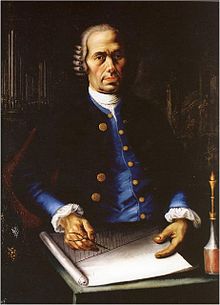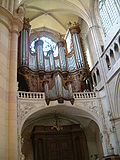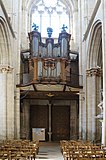Karl Joseph Riepp
Karl Joseph Riepp (born January 24, 1710 in Eldern ; † May 5, 1775 in Dijon ) was a German organ builder who, because of his extraordinary craftsmanship, received French citizenship as a royal privileged organ builder.
Life
Karl Joseph Riepp was born on January 24, 1710 in Eldern near Ottobeuren in Upper Swabia . He completed his apprenticeship with his brother Rupert Riepp with Jörg Hofer in Ottobeuren. After 1731 Karl Joseph Riepp moved as a traveling journeyman to Strasbourg , where he hoped to be accepted by Andreas Silbermann . However, he then had to be content with Georg Friedrich Merckel (1691–1766), who could not be compared with Silbermann in terms of skill and performance. Nevertheless, Riepp was able to study Silbermann's art at every opportunity. Under this influence and the familiar echoes from Swabia, Riepp became a sought-after organ builder with his personally designed peculiarities of style. In 1741 he married in Dole Anne Françoise Eve and settled in Dijon around 1742 . There, in association with his brother Rupert Riepp, he built his largest organ in France for the Cathedral of St. Bénigne . The young Riepp had proven himself to be a brilliant master and from then on could compete with every French colleague. This is particularly evidenced by the order for the organ of the Ste. Chapelle du Roy in Dijon, because whoever was entrusted with this organ building had to be considered the first organ builder in Burgundy and one of the best in the kingdom. In January 1747, King Louis XV awarded the brothers Karl Joseph and Rupert Riepp (born March 26, 1711, † May 2, 1749) French citizenship with the condition that they would remain in the country as "Facteurs d'orgues du Roy". Riepp was proud to count himself among the artists, enjoy their privileges and therefore also wear a wig and sword. The high artistic talents of the Riepp family were also revealed in his cousin, the painter Balthasar Riepp (1703–1764).
In addition to building organs, Karl Joseph Riepp traded in wine from his own vineyards in the best locations in Burgundy and ultimately became very wealthy. He exported vine seedlings to Salem , from which the “Burgundy” of the Lake Constance region passed down.
In terms of construction and sound, his instruments represent the type of the classical French organ. Riepp's dispositions prove that he was very at home in the field of acoustics and consciously recognized the nature and effect of the aliquot voices , and indeed their necessity in the tonal structure, in keeping with school. Their lengths and excellent intonation allow the boldest combinations with the basic voices, which are designed and executed with the same care. The reeds form a further essential tonal factor . There are the overtone-rich, short-cup tube works with their characterful, unsentimental sounds suitable for musical lines. But then the whole tone picture is determined by the cornets, the shining trumpets and clairons, by the penetrating bombards, the bell of which have coordinated lengths. But also the mixes and cymbals have to be considered, which Riepp built for Joseph Gabler all in normal choir numbers, which mix and combine well and grow dynamically depending on the stops drawn. A necessary plan prevails in the Riepp disposition, whereby all votes are conditional and indispensable. His students were Joseph Ludwig Weber, Gregor Rabini, Joseph Rabini (who took over the Riepps organ-building workshop in Dijon in 1777) and Johann Nepomuk Holzhey , whose instruments represent a synthesis of French and Upper Swabian sound elements.
Works
| year | place | church | image | Manuals | register | Remarks |
|---|---|---|---|---|---|---|
| 1737-1738 | Besançon | St. Vincent Abbey Church, main organ | Built in association with Rupert Riepp (not preserved). | |||
| 1738-1741 | Citeaux | Abbey church , main organ | Not received. | |||
| 1740-1743 | Dijon | Dijon Cathedral , main organ | 45 | Built in association with Rupert Riepp (original case / prospect pipes replaced during organ renovation in the 19th century / numerous Riepp registers preserved). | ||
| 1741-1744 | Dijon | Ste. Chapelle du Roy, organ | 30th | Built in association with Rupert Riepp (organ work completely changed by a new building in 1882 / Renaissance prospect in the local church of St. Michel). | ||
| 1745-1753 | Autun | St. Lazare Cathedral , main organ | 35 | Built in association with Rupert Riepp (replaced by a new building in 1875). | ||
| 1751 | Chalon-sur-Saône | St. Vincent Cathedral, organ | 14th | Receive. | ||
| 1750-1754 | Dole | Notre Dame Collegiate Church, main organ | IV / P | Riepp disposition that has not been handed down (original case and prospect pipes / organ remodeling in the 19th century while retaining the original play cabinet and 19 registers from Riepp). | ||
| 1754 | Langres | Sts-Pierre-et-Paul | 1777 transferred by Joseph Rabiny to the former collegiate church of Semur-en-Auxois . 1833 renovation by Joseph Callinet . | |||
| 1753-1756 | Beaune | Notre-Dame , main organ | IV / P | 37 | It lost its baroque sound character through renovation in the 19th century. → organ | |
| 1757-1766 | Ottobeuren | Abbey church , Trinity organ |
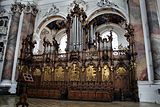
|
IV / P | 66 | The original housing, prospectus pipes, play cupboard, mechanics and disposition have been preserved. |
| 1762-1766 | Ottobeuren | Abbey church, Holy Spirit organ |
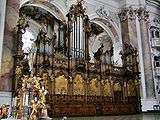
|
II / P | 27 | The original housing, prospectus pipes, play cupboard, mechanics and disposition have been preserved. |
| 1763-1764 | Besançon | Cathedral of St. Jean l'Evangeliste , main organ | 21 (?) | Rebuilt and expanded to 40 registers. | ||
| 1765-1766 | Besançon | St. Jean Baptiste , organ positive | 8th | Not received | ||
| 1766-1768 | Salem | Salem Minster , Liebfrauen organ |

|
III / P | 43 | After the secularization of the abbey, the Liebfrauen organ was transferred to the town church of Winterthur (photo) (13 registers received from Riepp). The corresponding parapet positive came to the church of St. Laurent in Charmey and forms the central part of the organ (prospect pipes from Riepp have been preserved). |
| 1769-1773 | Salem | Salem Minster , Trinity Organ |

|
III / P | 46 | Mechanics and disposition completely changed by Riepp during the renovation or new building in 1901, the case with the original prospect pipes preserved. |
| 1771-1774 | Salem | Salem Minster , tabernacle organ |
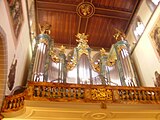
|
III / P | 34 | Numerous registers of the tabernacle organ were expanded as early as 1780 and inserted into the boxes of the choir stalls, so that the choir organ grew to 27 registers. This organ work was sold to Überlingen and was almost completely preserved in the Münster until 1888 (lost). The empty two-part cases with the no longer preserved prospect pipes were used in the Church of St. Stephan in Constance, where the original two-part case is connected by a central extension (photo); the corresponding parapet positive is missing. |
| Salem | Salem Minster , Orgue Ordinaire (choir organ) | I / P | 11 | |||
| 1769 | Besançon | Organ for the director of Besançon | Lost |
literature
- Andreas Jetter : The organ builder Karl Joseph Riepp (1710–1775) and the largest organ in the world in the Salem Minster . In: Life at the lake . Volume 27 2010, pp. 23–31
- Hermann Meyer: Karl Joseph Riepp. The organ builder from Ottobeuren . Bärenreiter-Verlag, Kassel 1938.
- Josef Edwin Miltschitzky: Ottobeuren: a European organ center. Organ builders, organs, and traditional organ music . Dissertation, University of Amsterdam 2012 ( full text )
- Theodor Wohnhaas : Riepp. In: Biographisch-Bibliographisches Kirchenlexikon (BBKL). Volume 8, Bautz, Herzberg 1994, ISBN 3-88309-053-0 , Sp. 334-335.
- Joseph Wörsching: The organ builder Karl Riepp (1710–1775) . Mainz 1940.
- Joseph Wörsching: The organ works of the Ottobeuren abbey . Ed .: Klosterladen GmbH, Benedictine Abbey Ottobeuren. Rheingold-Verlag, Mainz 1998 (first edition: 1959).
Web links
- Josef Miltschitzky: Karl Joseph Riepp and Rupert Riepp (PDF; 360 kB)
- The Riepp Organ at Dole. Organ description, portrait of Riepp. Retrieved September 18, 2012 .
| personal data | |
|---|---|
| SURNAME | Riepp, Karl Joseph |
| BRIEF DESCRIPTION | Organ builder |
| DATE OF BIRTH | January 24, 1710 |
| PLACE OF BIRTH | Elders |
| DATE OF DEATH | May 5, 1775 |
| Place of death | Dijon |
